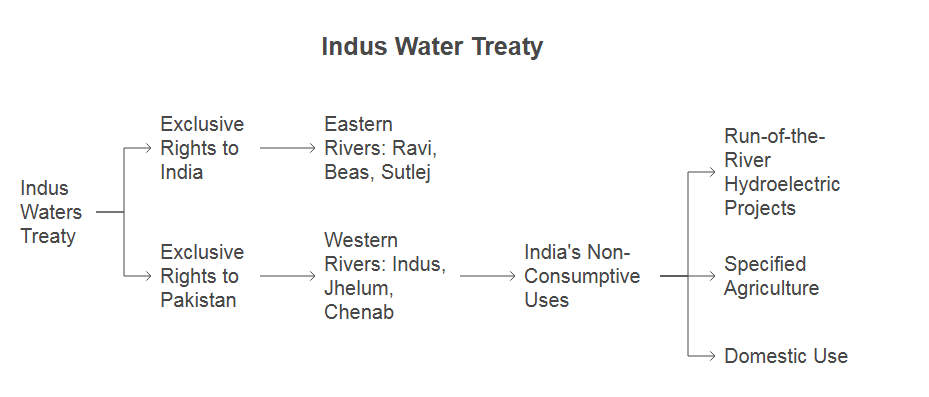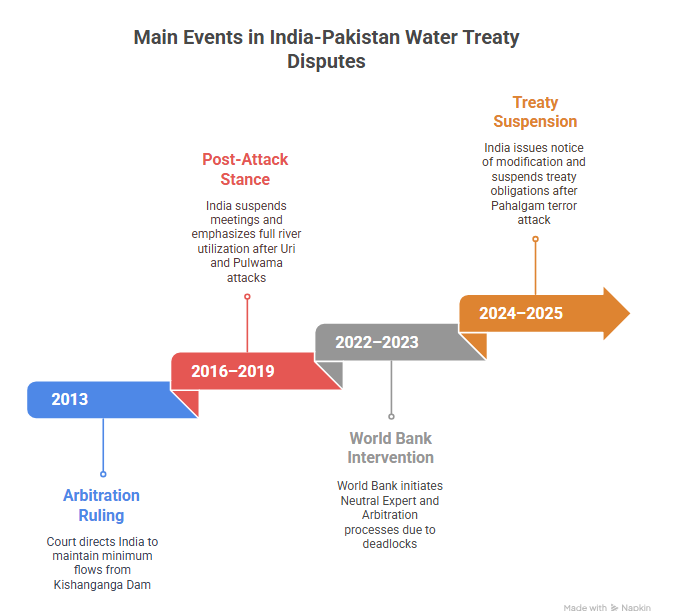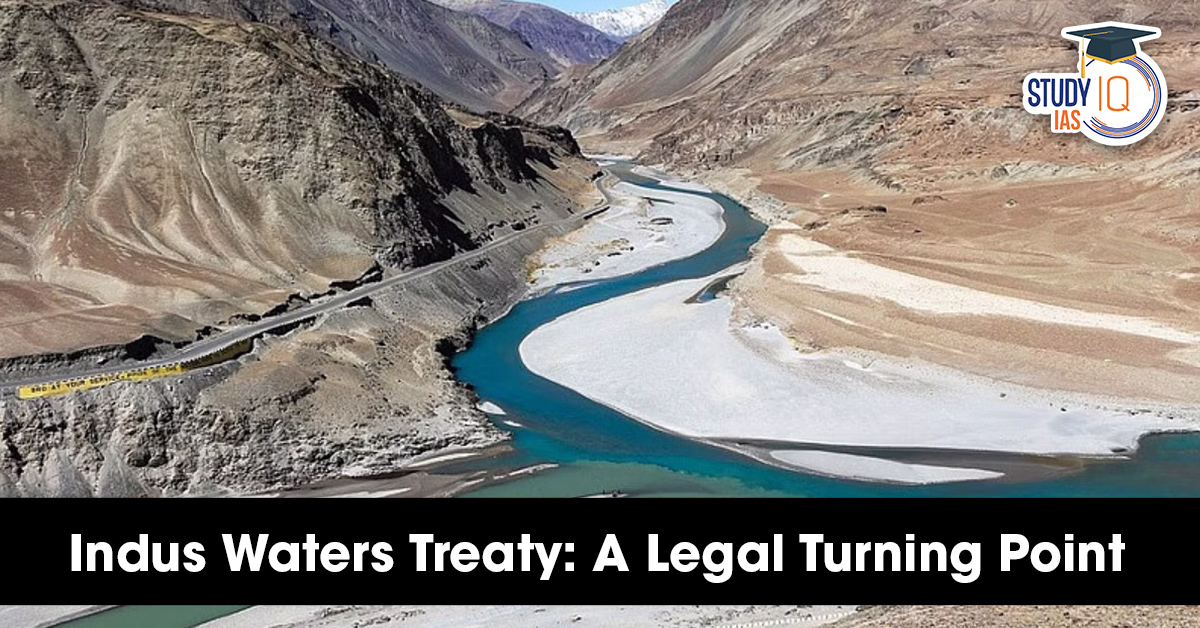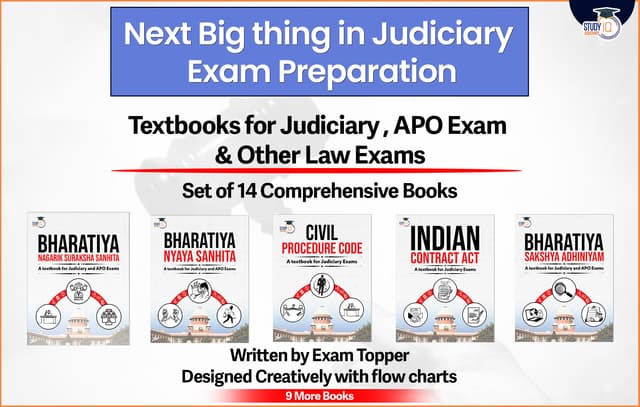Table of Contents
India’s recent decision to suspend its obligations under the Indus Waters Treaty (IWT) following the Pahalgam terror attack in 2025 has reignited legal and geopolitical debates. Signed in 1960 with World Bank facilitation, the IWT has been a hallmark of bilateral cooperation between India and Pakistan, withstanding wars and persistent hostilities. However, linking water diplomacy to National security concerns marks a significant departure from historical practice, raising questions about the treaty’s legal durability, enforcement mechanisms, and the broader implications under international water law and treaty law.
What is the Indus Waters Treaty of 1960?
The Indus Waters Treaty is a bilateral water-sharing agreement signed on 19th September 1960 in Karachi by Indian Prime Minister Jawaharlal Nehru, Pakistani President Mohammad Ayub Khan, and W.A.B. Iliff of the World Bank. The treaty governs the use of six rivers in the Indus system, aimed at equitable water distribution and peaceful conflict resolution.
It grants:
- Exclusive rights to India over the Eastern Rivers: Ravi, Beas, and Sutlej;
- Exclusive rights to Pakistan over the Western Rivers: Indus, Jhelum, and Chenab, with India permitted non-consumptive uses such as:
- Run-of-the-river hydroelectric projects (under design constraints),
- Specified agriculture,
- Domestic use.

Main Features of the Treaty
- Permanent Indus Commission (PIC):
Comprising one Commissioner from each country, this body facilitates routine data exchange and cooperative oversight. - Three-Tier Dispute Resolution Mechanism:
- Questions resolved through the PIC,
- Differences referred to a Neutral Expert (appointed by the World Bank),
- Disputes escalated to a Court of Arbitration.
- Data Exchange Obligation:
Monthly sharing of hydrological data is mandated to ensure transparency. - Legal Nature:
The treaty is perpetual under Article XII, with no exit clause, and requires mutual consent for termination or amendment.
Recent Developments and Challenges
- 2013: The Court of Arbitration directed India to maintain minimum flows from the Kishanganga Dam.
- 2016–2019: Post-Uri and Pulwama attacks, India signalled an assertive stance by suspending meetings and emphasising full utilisation of eastern rivers.
- 2022–2023: World Bank initiated parallel processes—Neutral Expert and Arbitration—due to procedural deadlocks.
- 2024–2025: India issued a formal notice of modification and suspended treaty obligations after the Pahalgam terror attack, invoking national security.
This shift indicates India’s growing inclination to use water as a strategic lever, directly correlating diplomatic compliance with counter-terrorism measures.

Legal Framework Governing the Treaty
Perpetual Nature under Article XII
- Article XII(3) of the IWT categorically states that the treaty “shall remain in force until terminated by a duly ratified treaty concluded for that purpose.”
- This clause renders unilateral suspension or withdrawal legally impermissible, necessitating mutual consent.
Vienna Convention on the Law of Treaties (VCLT)
- Article 26: Pacta sunt servanda — treaties must be honored in good faith.
- Article 60: Allows suspension only in case of material breach. Terrorism, though serious, may not qualify legally.
- Article 62: The Doctrine of rebus sic stantibus (fundamental change of circumstances) has a high threshold not typically met by terrorism-related events.
Dispute Resolution Constraints
- Suspension by one party undermines the PIC, Neutral Expert, and Arbitration mechanisms, all of which depend on bilateral participation.
- No independent enforcement mechanism exists within the treaty to compel compliance.
Jurisdictional and Procedural Barriers
- India’s reservation to Article 36(2) of the ICJ Statute excludes jurisdiction over disputes with Commonwealth countries like Pakistan.
- General international law does not provide for compulsory jurisdiction over water treaties unless consent is expressed.
Customary International Water Law
Even beyond treaty law, India’s unilateral suspension may conflict with:
- Principles of equitable and reasonable utilization, and
- Obligation not to cause significant harm to other riparian states.
These principles exist independently of IWT and are considered binding under customary international law.
Enforcement and Response Dilemma
- Pakistan lacks a clear legal forum to challenge the suspension effectively.
- Any counter-measures must conform to the Articles on State Responsibility:
- Must be non-violent,
- Proportionate to the breach,
- Intended to induce compliance, not retaliation.
Why This Matters?
- It challenges the permanency of international treaties in the face of evolving threats.
- Raises questions about the intersection of security and treaty law.
- Sets a potential precedent for future resource-based diplomacy in South Asia.
- The situation underscores the fragility of legal mechanisms in asymmetric bilateral relations.
The Indus Waters Treaty, long hailed as a model of transboundary cooperation, now stands at a legal and diplomatic crossroads. India’s 2025 suspension, prompted by the Pahalgam attack, signals a shift in doctrine, transforming water from a shared right into a strategic asset. While rooted in legitimate security concerns, this action disrupts established treaty obligations, tests the limits of international law, and reshapes the contours of India-Pakistan water diplomacy. The path ahead must reconcile the imperatives of national security, legal obligations, and regional stability, lest a river system once unifying turns divisive.


 Reserved vs General Quota: Supreme Court...
Reserved vs General Quota: Supreme Court...
 Supreme Court’s Interim Order on the W...
Supreme Court’s Interim Order on the W...



















